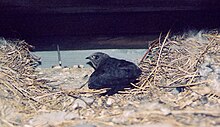Pallid Swift
| Pallid Swift | ||||||||||
|---|---|---|---|---|---|---|---|---|---|---|

Pallid swift in Tarifa , Spain |
||||||||||
| Systematics | ||||||||||
|
||||||||||
| Scientific name | ||||||||||
| Apus pallidus | ||||||||||
| ( Shelley , 1870) |
The pale swift ( Apus pallidus ) is a species of bird from the family of sailors (Apodidae). The species looks very similar to the common swift in Central Europe , but occurs in Europe only in the extreme south.
description
Pallid swifts are just as tall as common swifts and have the same build. They have a short forked tail, torpedo-shaped trunk, and long, sickle-shaped wings. They reach a length of 16 to 18 centimeters. The wing length is 16.5 to 18 centimeters, the beak length about 0.5 centimeters and the weight 32 to 44 grams.
In terms of color, it is also very similar to the common swift. The soot-colored plumage contrasts with a conspicuous white throat patch, which is often visible from a distance. Compared to the Common Swift, it is more squat, overall lighter and more brown on the underside and shows fine scaling here. In addition, the inner wings of the hand and the wings of the arm are a little lighter brown than the rest of the plumage and therefore contrast with the rest of the underside color. The pale swift's piercing, lofty reputation is deeper, more of a two-syllable "vriiie-e" and sounds more mechanical than that of the common swift.
distribution
The pale swift lives in numerous disjoint occurrences in the Mediterranean zone of the western Palearctic from Madeira and the Canary Islands via southern Europe and North Africa, Turkey , Israel and Lebanon to Iran and western Pakistan . In Central Europe, the species is an extremely rare exception, which is certainly also due to the very difficult differentiation from common swifts under outdoor conditions.
Way of life
Like the common swift, the species hunts small insects and spiders in the open air and only touches solid ground when breeding. Pallid swifts are migratory birds that overwinter in southern Africa. The pale swift returns to the breeding areas in southern Europe in April and leaves them in September.
Reproduction
Pallid swifts breed on cliffs and buildings, often together with common swifts. The clutch is located in a cavity and is padded with a pad of leaves. The usually two white eggs are incubated by both partners for 14 to 20 days. The young can fledge after 44 to 48 days. There are up to two annual broods.
Subspecies
There are three known subspecies:
- A. p. brehmorum Hartert , 1901 - This subspecies occurs on Madeira and the Canary Islands , the coastal areas of North Africa , southern Europe and Turkey .
- A. p. illyricus Tschusi , 1907 - This subspecies is common on the northwestern coasts of the Balkan Peninsula .
- A. p. pallidus ( Shelley , 1870) - The nominate form occurs from Mauritania via Egypt and the Middle East to Pakistan .
literature
- Lars Svensson , Peter J. Grant, Killian Mullarney, Dan Zetterström: The new cosmos bird guide. Kosmos, Stuttgart 1999, ISBN 3-440-07720-9 .
- Einhard Bezzel: Compendium of the birds of Central Europe. Nonpasseriformes - non-singing birds . Auditorium, Wiesbaden; 1985. ISBN 3-89104-424-0
- George Ernest Shelley: During my last visit to Egypt I procured two birds, which do not appear to have been previously described. I therefore take the opportunity of bringing them to the notice of ornithologists . In: The Ibis (= New series ). tape 6 , 1870, p. 445-448 ( online [accessed April 18, 2015]).
- Victor Ritter von Tschusi zu Schmidhoffen : About Palaearctic forms. (XIII.) . In: Ornithological Yearbook . tape 18 , no. 4 , 1907, pp. 27-30 ( online [PDF; 1.8 MB ; accessed on April 18, 2015]).
- Ernst Johann Otto Hartert in Johann Friedrich Naumann: Natural history of the birds of Central Europe . tape 4 . Ms. Eugen Köhler, Gera-Untermhaus 1901.
Web links
- Apus pallidus in the endangered Red List species the IUCN 2008. Posted by: BirdLife International, 2008. Accessed on 24 February, 2009.
- Age and gender characteristics (PDF; 2.6 MB) by J. Blasco-Zumeta and G.-M. Heinze (English)
Individual evidence
- ^ IOC World Bird List Owlet-nightjars, treeswifts & swifts
- ↑ Ernst Johann Otto Hartert, p. 233.
- ↑ Victor Ritter von Tschusi zu Schmidhoffen, p. 29.
- ↑ George Ernest Shelley, p. 445.

